The Sudachi Market is estimated to be valued at USD 50.4 million in 2025 and is projected to reach USD 59.6 million by 2035, registering a compound annual growth rate (CAGR) of 1.7% over the forecast period.
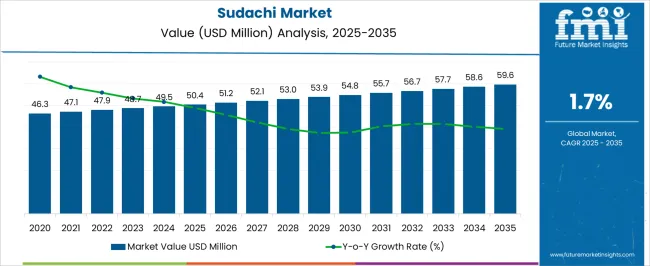
| Metric | Value |
|---|---|
| Sudachi Market Estimated Value in (2025 E) | USD 50.4 million |
| Sudachi Market Forecast Value in (2035 F) | USD 59.6 million |
| Forecast CAGR (2025 to 2035) | 1.7% |
The Sudachi market is currently experiencing steady expansion, driven by rising global interest in unique and region-specific citrus varieties. Recognized for its sharp acidity and rich aromatic profile, Sudachi is gaining traction across culinary, beverage, and wellness industries. Growing demand for natural flavor enhancers and clean-label ingredients is encouraging manufacturers to explore fruit-based alternatives in both processed and fresh formats.
Technological advancements in cold-chain logistics and post-harvest preservation are enabling wider market access and reducing supply chain losses. Moreover, the rising prominence of Japanese cuisine globally has elevated awareness and demand for indigenous citrus fruits like Sudachi.
Market players are focusing on controlled cultivation, value-added product formats such as concentrates and powdered extracts, and strategic collaborations with food and beverage brands. As consumer awareness of traceable sourcing and functional health benefits continues to rise, the Sudachi market is well-positioned for scalable growth across international markets, with opportunities expanding in both specialty and mass-market segments.
The market is segmented by Type and Application and region. By Type, the market is divided into Fuel Type, Food Type, and Fuel Type. In terms of Application, the market is classified into Food & Beverages, Animal Feed, Dietary Supplements, Pharmaceuticals, Personal Care, Bio Fuels, and Others. Regionally, the market is classified into North America, Latin America, Western Europe, Eastern Europe, Balkan & Baltic Countries, Russia & Belarus, Central Asia, East Asia, South Asia & Pacific, and the Middle East & Africa.
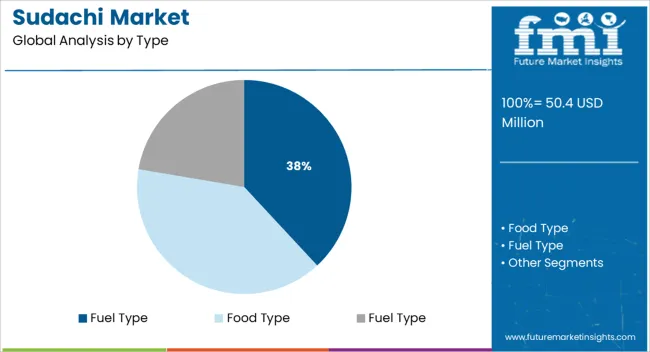
The fuel type segment is projected to account for 38.1% of the Sudachi market revenue in 2025, making it the leading category within type-based segmentation. This leadership is being driven by the use of Sudachi-derived bioactive compounds in natural fuel and energy formulations.
The extract’s high acidity and antioxidant properties have enabled its incorporation into metabolic health beverages and plant-based energizers, aligning with global trends toward clean and green energy sources. Innovations in extraction technologies have improved yield efficiency and enabled the conversion of Sudachi waste or by-products into biofuel ingredients, enhancing its commercial viability.
Producers are also focusing on sustainability-linked applications where Sudachi inputs can reduce the environmental impact of conventional fuel enhancers. Regulatory encouragement for natural and renewable fuel additives has further contributed to segmental growth, positioning the fuel type application as a major contributor to the market’s overall performance.
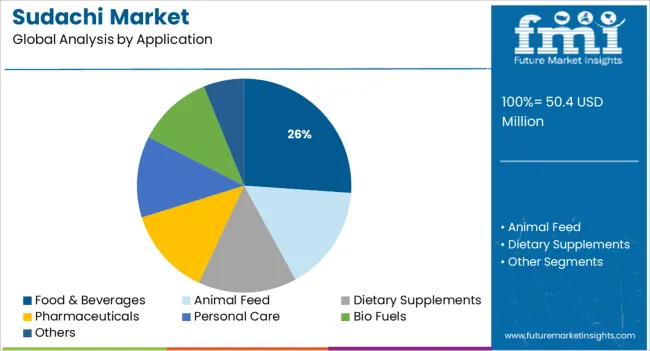
Within the application category, the food and beverages segment is expected to hold 26.1% of the total market share in 2025, making it the dominant segment. The leadership of this segment is attributed to the increasing demand for natural citrus flavoring in culinary preparations, ready-to-drink products, and gourmet formulations.
Sudachi’s unique flavor profile has been widely embraced in sauces, marinades, alcoholic drinks, and artisanal foods, especially where regional authenticity is valued. As clean-label trends grow stronger, food manufacturers are shifting from synthetic ingredients to naturally sourced options such as Sudachi extracts and concentrates.
Its rich content of limonoids, vitamin C, and polyphenols further supports its use in functional food and beverage development. The rise in exports of Japanese and East Asian specialty ingredients to North America and Europe has expanded market access, reinforcing the dominance of food and beverages as the largest application segment in the Sudachi market.
Consumer awareness of the importance of health is boosting interest in the use of natural flavoring agents in food and beverage products, resulting in increased usage of the product along with boosting the size of the sudachi market in various parts of the world.
It provides health benefits and is frequently used as a lime alternative, resulting in increased consumer knowledge of health and acceptance of novel flavors, which is driving the sudachi market towards expansion during the forecast period. In addition, the increased adoption of sudachi as a flavor enhancer in desserts and non-alcoholic drinks is likely to boost the sudachi market.
Consumption of artificial flavorings in food products can cause allergic responses, abdominal pain, exacerbation of asthmatic symptoms, vomiting, food hypersensitivity, and diarrhea, to name a few.
As a result, greater awareness of the negative effects of chemical components that cause allergies is projected to enhance overall such statistics.
Sudachi is becoming more popular as a substitute for fake citrus flavors. Vitamin C, phosphorus, calcium, magnesium, and potassium, are all abundant in sudachi fruit naturally. As a result, there are numerous health benefits to eating sudachi. Furthermore, sudachi is grown in greenhouses, ensuring year-round availability, therefore, pushing up the consumption of the product to various parts of the world.
The market is projected to see a boom in the coming years as consumers' lifestyles change and rise disposable income. Sudachi is commonly used in meat, salads, seafood meals, and desserts because it enhances the flavor of the product without adding calories, which helps in the growth of the sudachi market.
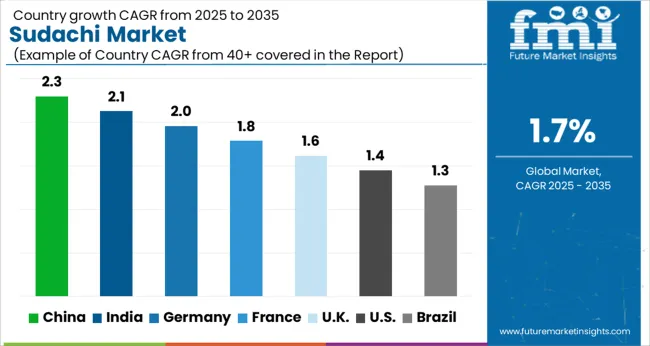
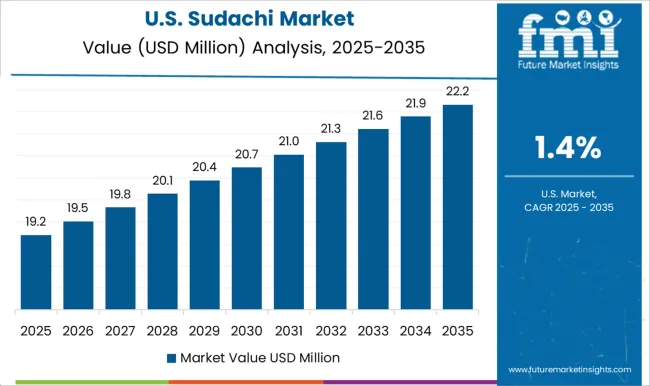
The potential in the low-calorie food sector is expected to grow as the prevalence of diabetes rises across the country which accelerates the expansion of the sudachi market.
Since the outbreak of the COVID-19 pandemic, the USA population has become increasingly interested in eating healthy, low-calorie foods. This tendency is projected to support the trends and opportunities and the growth of the market n the USA.
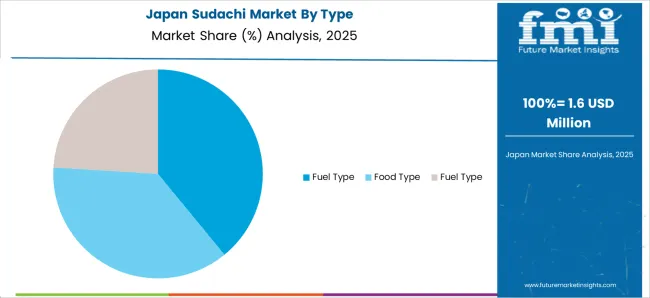
Key reasons driving the sudachi market growth include rising use of the product along with natural citrus flavors, increased demand for Japanese cuisine, and increased consumer knowledge of sudachi. Sudachi is becoming increasingly popular because of its distinct flavor and is often used as a nutritious component in the preparation of pork, fish, poultry, and salads in the country which impacts the sudachi market trends in near future.
Due to its booming natural citrus flavor sector, China presently dominates the global sudachi market. Asia Pacific is a major sudachi producer, with the product being exported to countries across the world.
The beverage business in the region is booming, thanks to natural taste innovation. As a result, statistics in China are predicted to accelerate as a result of such circumstances.
The juice segment in the sudachi market is expected to approach USD 59.6 Million by 2035, with a CAGR of around 1.6%. It is most commonly taken as a juice, and because of its liquid nature, it is simple to blend and cook with a variety of foods. Although it has a shorter shelf life than sudachi powder, its compatibility with food makes it a superior choice.
When compared to puree and powder, the production of sudachi juice is less complicated and time-intensive. As a result, this component aids the sudachi market expansion.
The sudachi market is divided into three applications: beverage, food, and others. Food is further subdivided into the bakery, meat, poultry, seafood, sauces and dressings, desserts, and others.
Among these, the sauces and dressings segment is expected to grow by 1.2% over the forecast period. The meat, poultry, and seafood segment are expected to grow by 1.4% in the coming year.
The native fruit is mostly squeezed over Japanese grilled fish dishes. Sudachi, with its pleasant fragrance and tangy flavor, is known to reduce fishy odor and taste which positively influences the sudachi market during the forecast period.
The bakery segment will grow by more than 0.7%. Sudachi juice is also excellent for a variety of bakery items, including pastry fillings and cakes. Meanwhile, the other food segment is expected to grow by 1.0%.
The other application segment is expected to grow at a rate of 0.9% in the coming year. Sudachi is known to have numerous health benefits in addition to other advantages. It has been shown to help with calcium absorption and blood sugar regulation.
It can help to boost the immune system, reduce inflammation, and improve blood circulation if consumed on a regular basis, and impacts the opportunities in the sudachi market.
Desserts are the fastest expanding sub-segment in the food industry, because of the increased usage of sudachi in mousse, ice creams, ice pops, and other desserts.
Sudachi manufacturers are continuously experimenting with food products especially desserts, in order to provide consumers with unique products and gain a competitive advantage. This is leading to rapidly emerging trends in the dessert category.
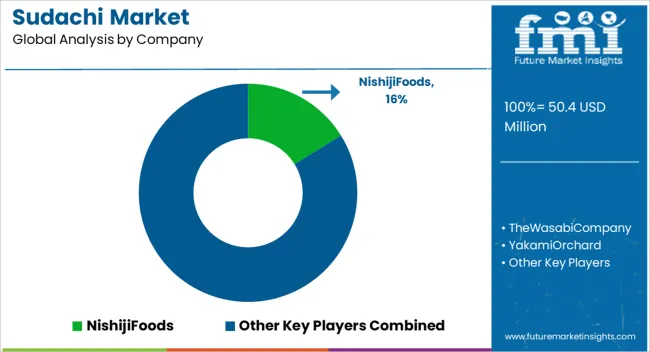
To increase overall sudachi market share, companies are implementing strategic initiatives such as collaboration and M&As. As the global sudachi market is still in its infancy, only small and medium-sized businesses sell the products. In the foreseeable time frame increased consumption of various food products is likely to boost the number of new entrants.
The biggies are investing in expanding their production capacities, either by building new manufacturing facilities or increasing the capacity of their existing manufacturing plants, in order to meet the consumer demand in the forum.
| Attribute | Details |
|---|---|
| Forecast Period | 2025 to 2035 |
| Historical Data Available for | 2020 to 2024 |
| Market Analysis | USD Million for Value and MT for Volume |
| Key Regions Covered | North America; Latin America; Europe; Asia Pacific; and the Middle East and Africa |
| Key Countries Covered | USA, Canada, Mexico, Germany, United Kingdom, France, Italy, China, Japan, South Korea, Australia, Brazil, Middle East, Africa, and others |
| Key Segments Covered | Type, Application, and Region |
| Key Companies Profiled | Nishiji foods; The Wasabi Company; Yakami Orchard; The Bando Foods Company; Yuzuya Honten Co., Ltd.; SICA SAS SICODIS; Ponthier Sas; Barth Fruit AG; HIKARI FOODS CO., LTD.; Nishikidôri SASU PALMIFRANCE; Others |
| Report Coverage | Market Forecast, Company Share Analysis, Competition Intelligence, Drivers, Restraints, Opportunities and Threats Analysis, Market Dynamics and Challenges, and Strategic Growth Initiatives |
| Customization & Pricing | Available upon Request |
The global sudachi market is estimated to be valued at USD 50.4 million in 2025.
The market size for the sudachi market is projected to reach USD 59.6 million by 2035.
The sudachi market is expected to grow at a 1.7% CAGR between 2025 and 2035.
The key product types in sudachi market are fuel type, food type and fuel type.
In terms of application, food & beverages segment to command 26.1% share in the sudachi market in 2025.






Full Research Suite comprises of:
Market outlook & trends analysis
Interviews & case studies
Strategic recommendations
Vendor profiles & capabilities analysis
5-year forecasts
8 regions and 60+ country-level data splits
Market segment data splits
12 months of continuous data updates
DELIVERED AS:
PDF EXCEL ONLINE

Thank you!
You will receive an email from our Business Development Manager. Please be sure to check your SPAM/JUNK folder too.
Chat With
MaRIA